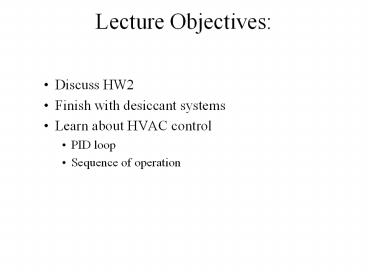Lecture Objectives: - PowerPoint PPT Presentation
Title:
Lecture Objectives:
Description:
Title: Slide 1 Author: Jeffrey Siegel Last modified by: CFDprc1 Created Date: 8/16/2002 11:00:28 PM Document presentation format: On-screen Show (4:3) – PowerPoint PPT presentation
Number of Views:44
Avg rating:3.0/5.0
Title: Lecture Objectives:
1
Lecture Objectives
- Discuss HW2
- Finish with desiccant systems
- Learn about HVAC control
- PID loop
- Sequence of operation
2
Desiccant wheel
3
Variation in Cycles
Much more in the paper I gave you (Technical
development of rotary desiccant dehumidification
and air conditioning)
4
Control
- Process controls
- Self-powered controls
- Pneumatic and electro-mechanical controls
- Electronic controls
- Direct digital control (DDC)
- Predictive control
- .
5
Terminology
- Sensor
- Measures quantity of interest
- Controller
- Interprets sensor data
- Controlled device
- Changes based on controller output
Figure 2-13
6
outdoor
Direct Closed Loop or Feedback
Indirect Open Loop or Feedforward
7
- Set Point
- Desired sensor value
- Control Point
- Current sensor value
- Error or Offset
- Difference between control point and set point
8
Two-Position Control Systems
- Used in small, relatively simple systems
- Controlled device is on or off
- It is a switch, not a valve
- Good for devices that change slowly
9
Modulating Control Systems
- Example Heat exchanger control
- Modulating (Analog) control
x
(set point temperature)
10
Modulating Control Systems
- Used in larger systems
- Output can be anywhere in operating range
- Three main types
- Proportional
- PI
- PID
11
Proportional Controllers
- x is controller output
- A is controller output with no error
- (often A0)
- Kis proportional gain constant
- e is error
(offset)
12
Stable system
Unstable system
13
Issues with P Controllers
- Always have an offset
- But, require less tuning than other controllers
- Very appropriate for things that change slowly
- i.e. building internal temperature
14
Proportional Integral (PI)
K/Ti is integral gain
If controller is tuned properly, offset is
reduced to zero
Figure 2-18a
15
(No Transcript)
16
Issues with PI Controllers
- Scheduling issues
- Require more tuning than for P
- But, no offset
17
Proportional Integral Derivative (PID)
- Improvement over PI because of faster response
and less deviation from offset - Increases rate of error correction as errors get
larger - But
- HVAC controlled devices are too slow responding
- Requires setting three different gains
18
Ref Kreider and Rabl.Figure 12.5
19
The control in HVAC system only PI
Proportional
Integral
value
Set point
Proportional affect the slope
Integral affect the shape after the first bump
Set point
20
The Real World
- 50 of US buildings have control problems
- 90 tuning and optimization
- 10 faults
- 25 energy savings from correcting control
problems - Commissioning is critically important
21
HVAC Control
- Example
- Dew point control (Relative Humidity control)
fresh air
filter
cooling coil
heating coil
filter
damper
fan
mixing
T RH sensors
Heat gains
Humidity generation
We should supply air with lower humidity ratio
(w) and lower temperature
We either measure Dew Point directly or T RH
sensors substitute dew point sensor
22
Relative humidity control by cooling coil
Cooling Coil
Mixture
Room
Supply
TDP
Heating coil
23
Relative humidity control by cooling coil (CC)
- Cooling coil is controlled by TDP set-point
- if TDP measured gt TDP set-point ? send the
signal to open more the CC valve - if TDP measured lt TDP set-point ? send the
signal to close more the CC valve
- Heating coil is controlled by Tair set-point
- if Tair lt Tair set-point ? send the signal
to open more the heating coil valve - if Tair gt Tair set-point ? send the signal
to close more the heating coil valve
Control valves
Fresh air
mixing
cooling coil
heating coil
Tair TDP sensors
24
Sequence of operation(PRC research facility)
Control logic Mixture in zone 1 IF ((
TMltTSP) (DPTMltDPTSP) ) heating and
humidifying Heater control IF (TSPgtTSA)
increase heating or IF (TSPltTSA) decrease
heating Humidifier IF (DPTSPgtDPTSA) increase
humidifying or IF (DPTSPltDPTSA) decrease humid.
Mixture in zone 2 IF ((TMgtTSP)
(DPTMltDPTSP) ) cooling and humidifying Cool.
coil cont. IF (TSPltTSA) increase cooling or IF
(TSPgtTSA) decrease cooling Humidifier IF
(DPTSPgtDPTSA) increase humidifying or IF
(DPTSPltDPTSA) decrease hum. Mixture in zone 3
IF ((DPTMgtDPTSP) ) cooling/dehumidifying and
reheatin Cool. coil cont. IF (DPTSPgtDPTSA)
increase cooling or IF (DPTSPltDPTSA) decrease
cooling Heater control IF (TSPgtTSA) increase
heating or IF (TSPltTSA) decrease heating































